Abstract
Porphyromonas gingivalis is a suspected pathogen in rapidly progressive periodontitis (RPP). We have determined the anti-P. gingivalis serum immunoglobulin G (IgG) isotype response and avidity and the subclass titer distributions for 30 RPP patients and 30 age-, sex-, and race-matched healthy subjects by using enzyme-linked immunosorbent assay technology. Patients and control subjects were classified as seropositive if their total IgG response to P. gingivalis was twofold or more than the median response in healthy subjects. The predominant antibody responses for both patients and healthy subjects were IgG2 and IgG3, with a subclass order of IgG2 greater than IgG3 greater than IgG1 greater than IgG4. The avidity of the IgG response was highest for the seropositive healthy subjects and was no different between seronegative and seropositive RPP patients. The subclass antibody responses did not depend on gender, and there were no correlations between titer, avidity, or subclass with disease severity in the RPP patients as measured by pocket depth or bone loss on dental X rays. The seronegative RPP patients exhibited antibody responses that were greater than the responses of seronegative healthy subjects for all four subclasses, while the seropositive RPP patients had higher IgG1 and IgG4 levels than seropositive healthy subjects. These findings are consistent with the hypothesis that both carbohydrate and protein antigens are important in the IgG response to P. gingivalis. The relative predominance of IgG2, a subclass which lacks strong complement fixation and opsonic properties, and the low avidity of patient anti-P. gingivalis IgG antibodies suggest that humoral responsiveness to infection with P. gingivalis may be ineffective in clearing this organism.
Full text
PDF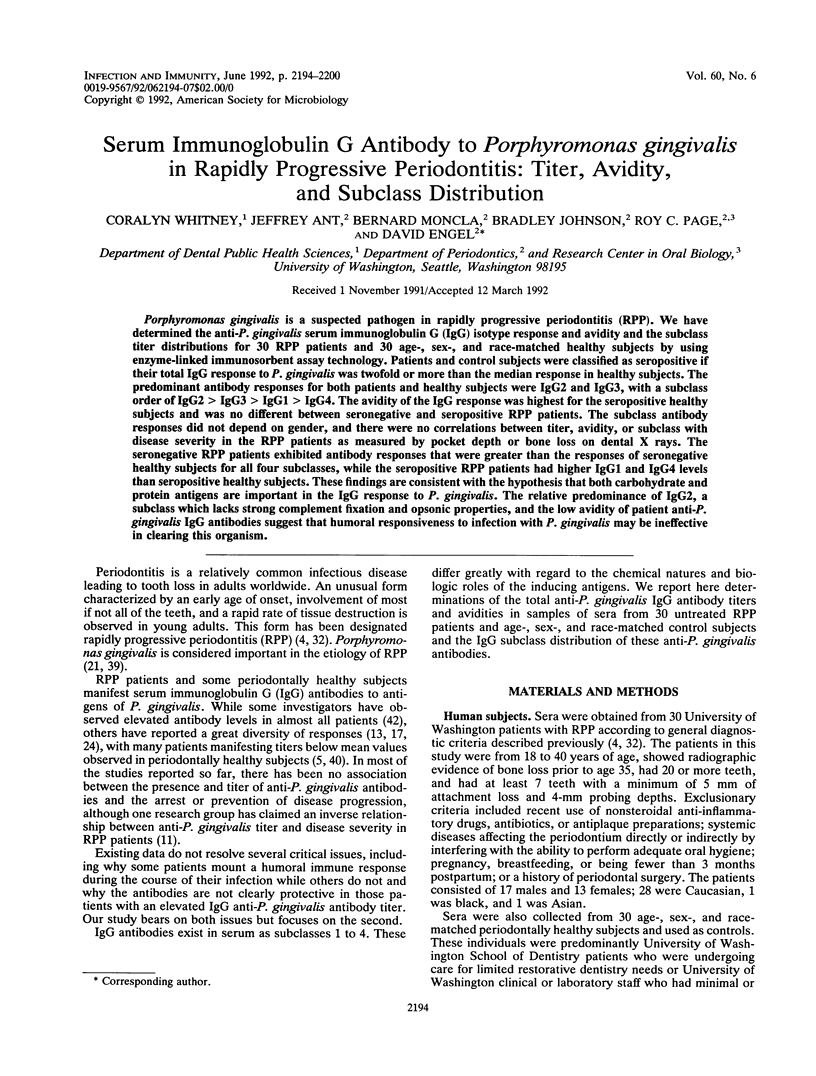
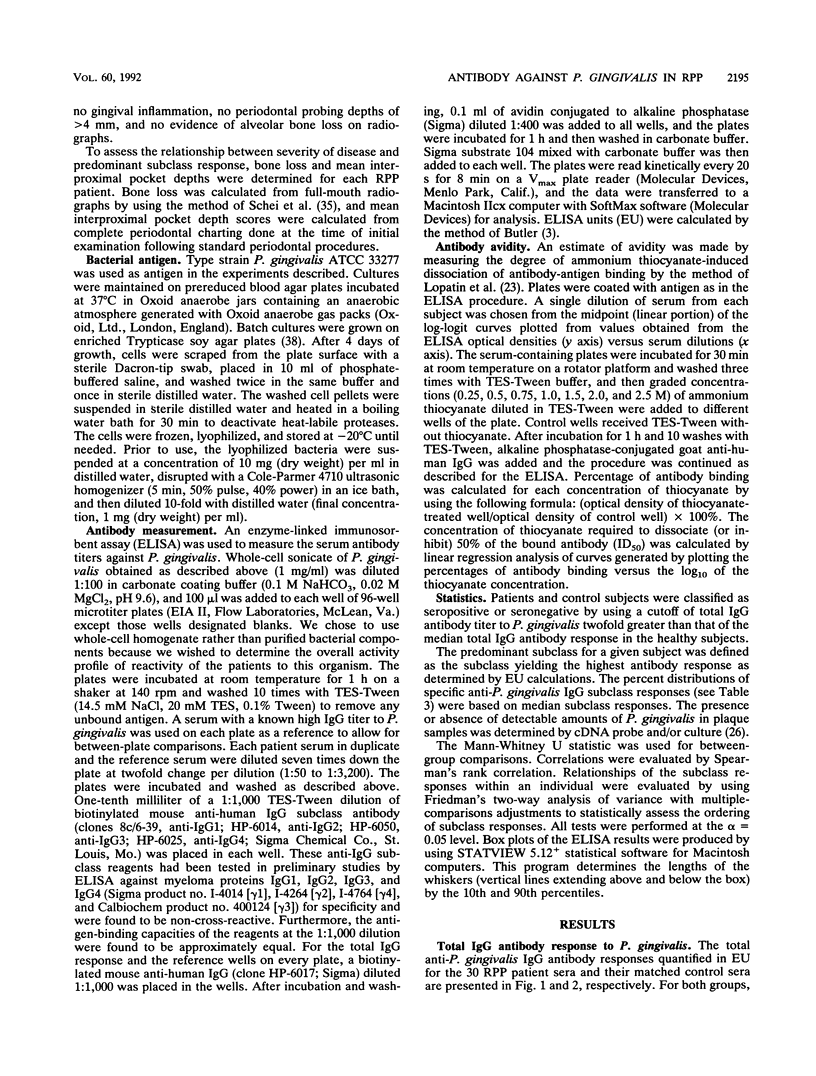
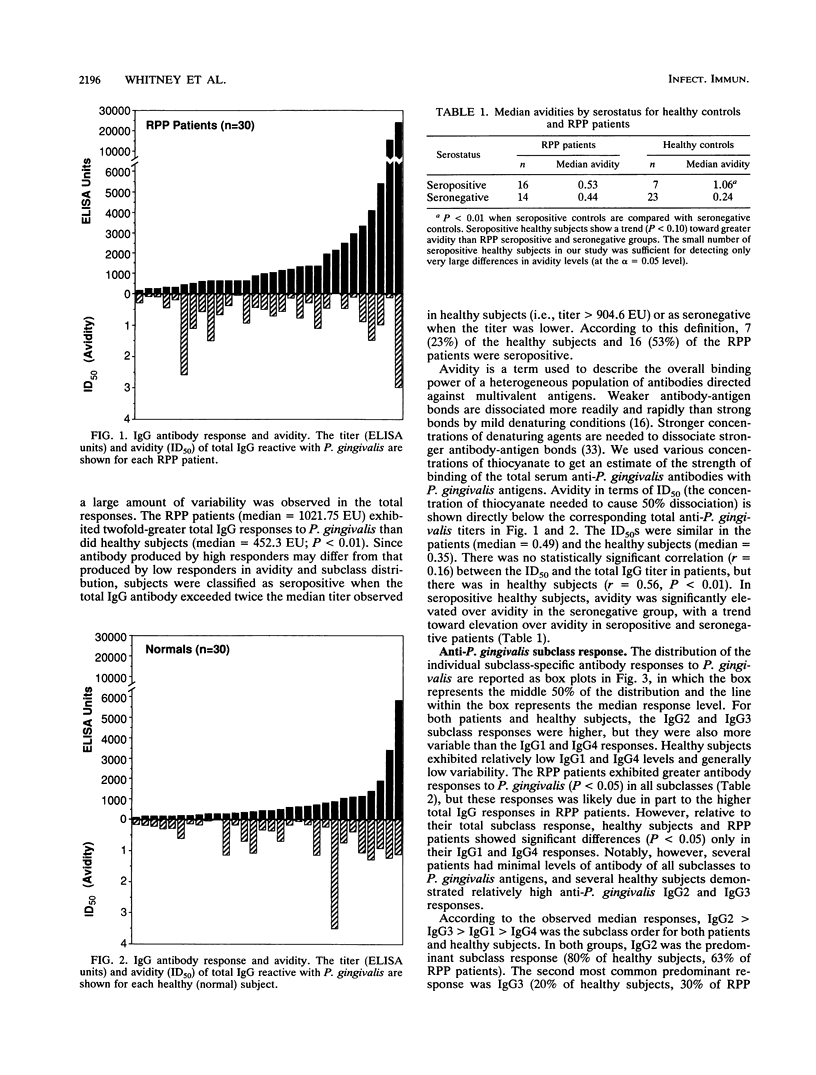
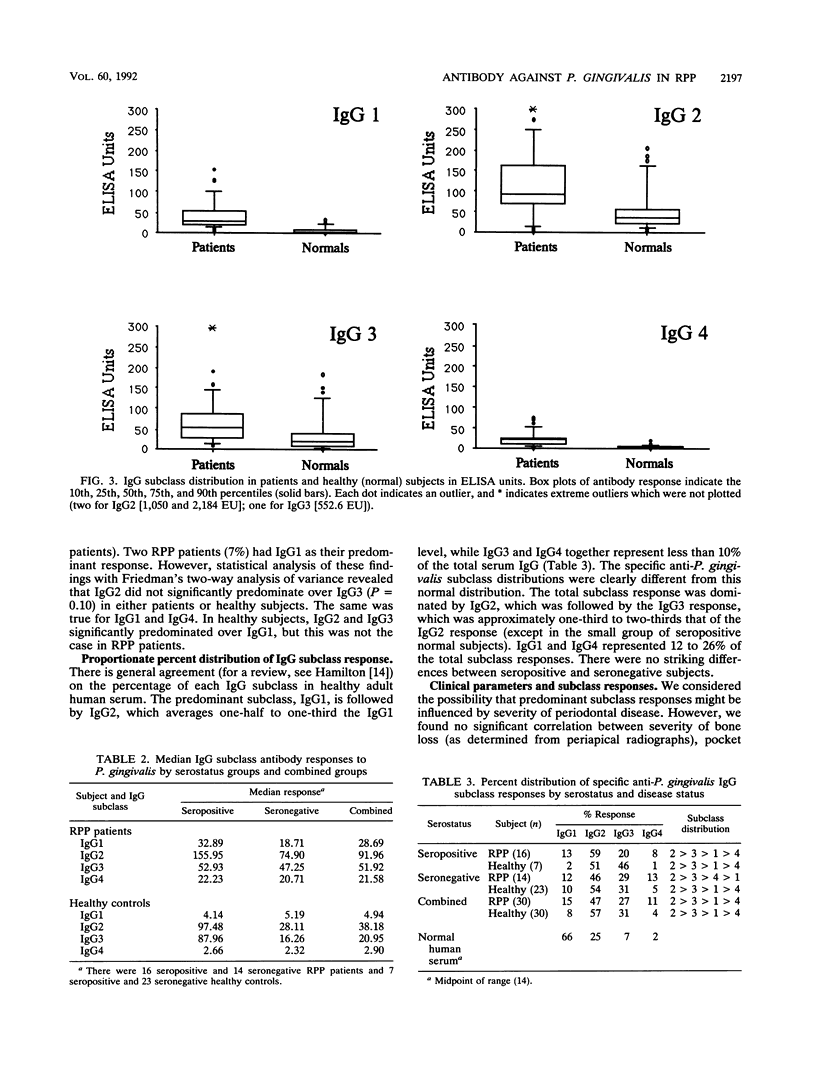
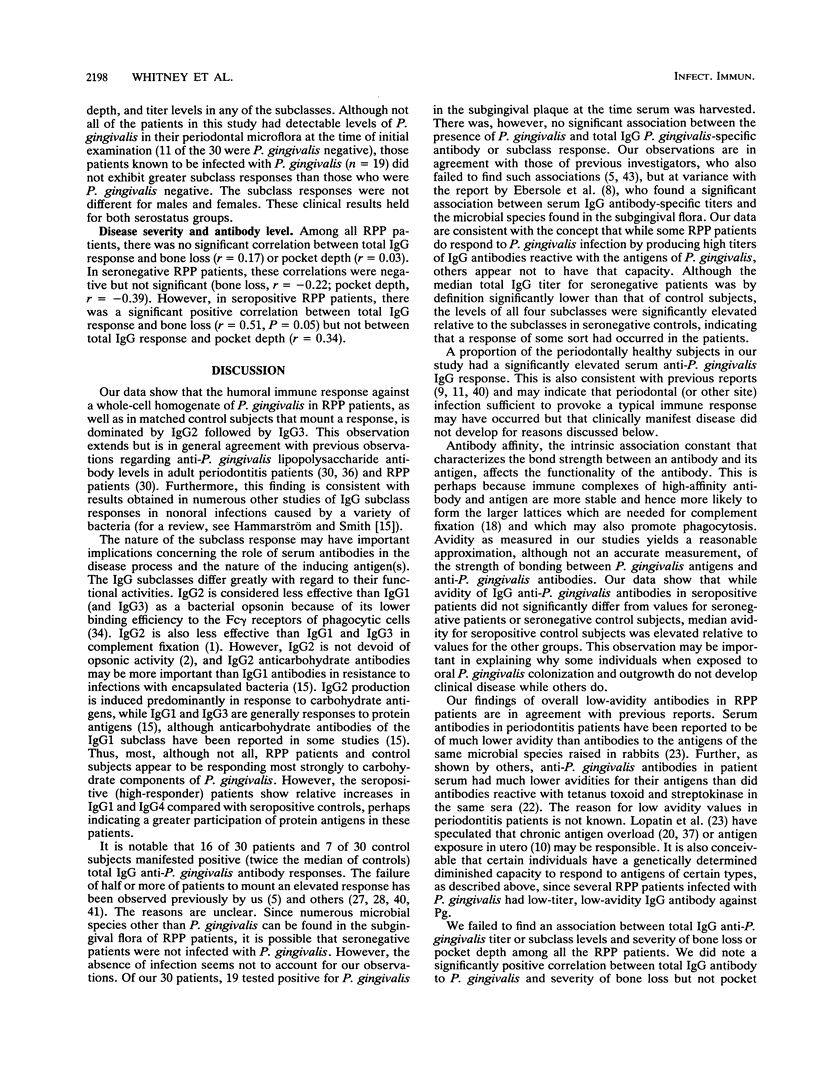
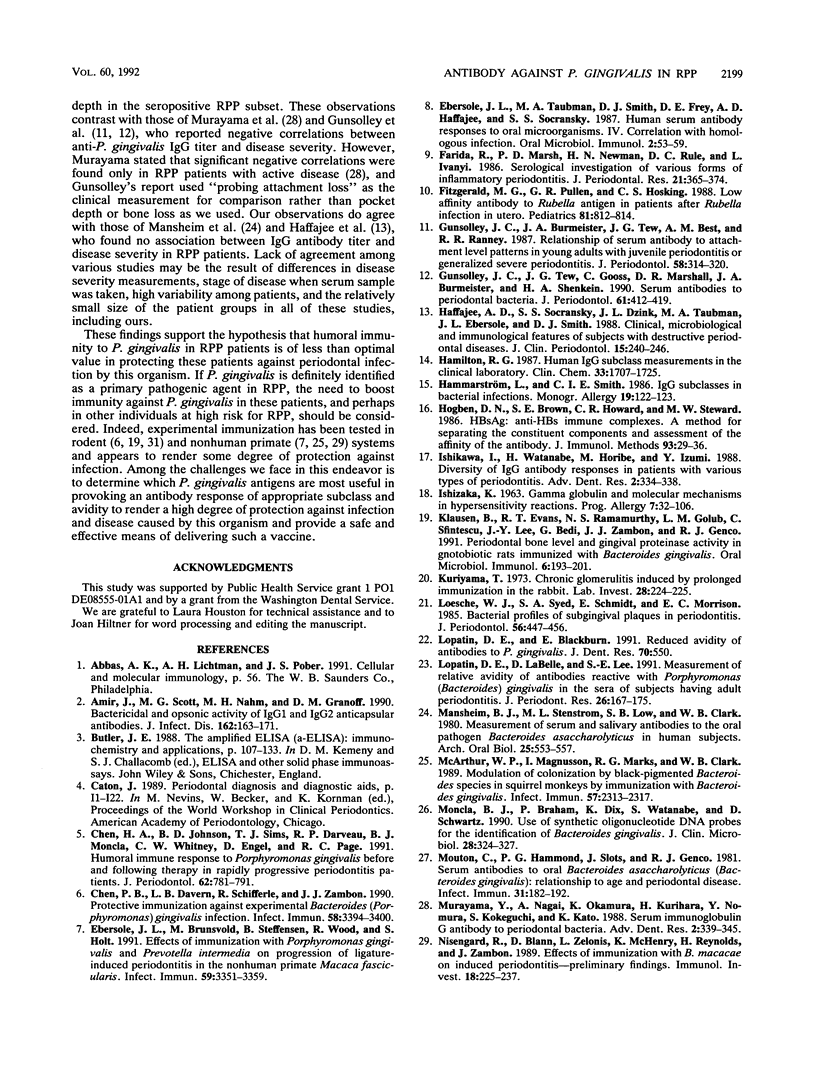
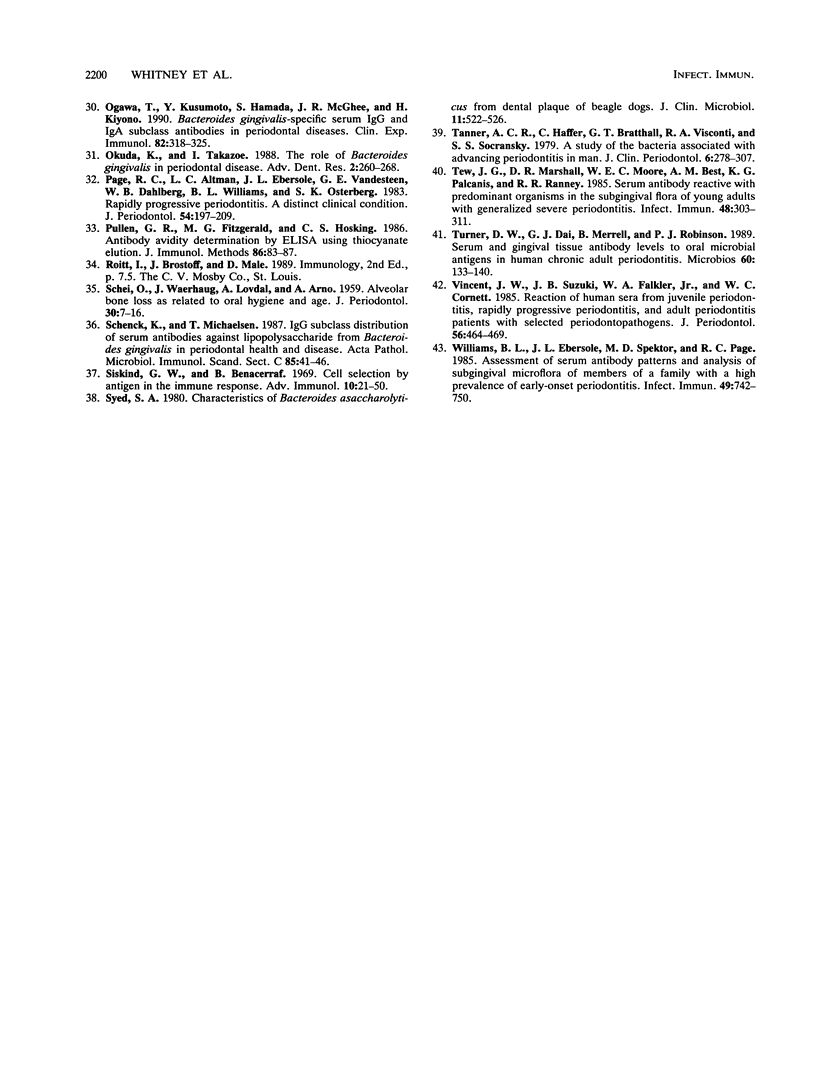
Selected References
These references are in PubMed. This may not be the complete list of references from this article.
- Amir J., Scott M. G., Nahm M. H., Granoff D. M. Bactericidal and opsonic activity of IgG1 and IgG2 anticapsular antibodies to Haemophilus influenzae type b. J Infect Dis. 1990 Jul;162(1):163–171. doi: 10.1093/infdis/162.1.163. [DOI] [PubMed] [Google Scholar]
- Chen H. A., Johnson B. D., Sims T. J., Darveau R. P., Moncla B. J., Whitney C. W., Engel D., Page R. C. Humoral immune responses to Porphyromonas gingivalis before and following therapy in rapidly progressive periodontitis patients. J Periodontol. 1991 Dec;62(12):781–791. doi: 10.1902/jop.1991.62.12.781. [DOI] [PubMed] [Google Scholar]
- Chen P. B., Davern L. B., Schifferle R., Zambon J. J. Protective immunization against experimental Bacteroides (Porphyromonas) gingivalis infection. Infect Immun. 1990 Oct;58(10):3394–3400. doi: 10.1128/iai.58.10.3394-3400.1990. [DOI] [PMC free article] [PubMed] [Google Scholar]
- Ebersole J. L., Brunsvold M., Steffensen B., Wood R., Holt S. C. Effects of immunization with Porphyromonas gingivalis and Prevotella intermedia on progression of ligature-induced periodontitis in the nonhuman primate Macaca fascicularis. Infect Immun. 1991 Oct;59(10):3351–3359. doi: 10.1128/iai.59.10.3351-3359.1991. [DOI] [PMC free article] [PubMed] [Google Scholar]
- Ebersole J. L., Taubman M. A., Smith D. J., Frey D. E., Haffajee A. D., Socransky S. S. Human serum antibody responses to oral microorganisms. IV. Correlation with homologous infection. Oral Microbiol Immunol. 1987 Jun;2(2):53–59. doi: 10.1111/j.1399-302x.1987.tb00290.x. [DOI] [PubMed] [Google Scholar]
- Farida R., Marsh P. D., Newman H. N., Rule D. C., Ivanyi L. Serological investigation of various forms of inflammatory periodontitis. J Periodontal Res. 1986 Jul;21(4):365–374. doi: 10.1111/j.1600-0765.1986.tb01470.x. [DOI] [PubMed] [Google Scholar]
- Fitzgerald M. G., Pullen G. R., Hosking C. S. Low affinity antibody to rubella antigen in patients after rubella infection in utero. Pediatrics. 1988 Jun;81(6):812–814. [PubMed] [Google Scholar]
- Gunsolley J. C., Burmeister J. A., Tew J. G., Best A. M., Ranney R. R. Relationship of serum antibody to attachment level patterns in young adults with juvenile periodontitis or generalized severe periodontitis. J Periodontol. 1987 May;58(5):314–320. doi: 10.1902/jop.1987.58.5.314. [DOI] [PubMed] [Google Scholar]
- Gunsolley J. C., Tew J. G., Gooss C., Marshall D. R., Burmeister J. A., Schenkein H. A. Serum antibodies to periodontal bacteria. J Periodontol. 1990 Jul;61(7):412–419. doi: 10.1902/jop.1990.61.7.412. [DOI] [PubMed] [Google Scholar]
- Haffajee A. D., Socransky S. S., Dzink J. L., Taubman M. A., Ebersole J. L., Smith D. J. Clinical, microbiological and immunological features of subjects with destructive periodontal diseases. J Clin Periodontol. 1988 Apr;15(4):240–246. doi: 10.1111/j.1600-051x.1988.tb01577.x. [DOI] [PubMed] [Google Scholar]
- Hamilton R. G. Human IgG subclass measurements in the clinical laboratory. Clin Chem. 1987 Oct;33(10):1707–1725. [PubMed] [Google Scholar]
- Hammarström L., Smith C. I. IgG subclasses in bacterial infections. Monogr Allergy. 1986;19:122–133. [PubMed] [Google Scholar]
- Hogben D. N., Brown S. E., Howard C. R., Steward M. W. HBsAg: anti-HBs immune complexes. A method for separating the constituent components and assessment of the affinity of the antibody. J Immunol Methods. 1986 Oct 23;93(1):29–36. doi: 10.1016/0022-1759(86)90429-1. [DOI] [PubMed] [Google Scholar]
- ISHIZAKA K. Gamma globulin and molecular mechanisms in hypersensitivity reactions. Prog Allergy. 1963;7:32–106. [PubMed] [Google Scholar]
- Ishikawa I., Watanabe H., Horibe M., Izumi Y. Diversity of IgG antibody responses in the patients with various types of periodontitis. Adv Dent Res. 1988 Nov;2(2):334–338. doi: 10.1177/08959374880020022301. [DOI] [PubMed] [Google Scholar]
- Klausen B., Evans R. T., Ramamurthy N. S., Golub L. M., Sfintescu C., Lee J. Y., Bedi G., Zambon J. J., Genco R. J. Periodontal bone level and gingival proteinase activity in gnotobiotic rats immunized with Bacteroides gingivalis. Oral Microbiol Immunol. 1991 Aug;6(4):193–201. doi: 10.1111/j.1399-302x.1991.tb00477.x. [DOI] [PubMed] [Google Scholar]
- Kuriyama T. Chronic glomerulonephritis induced by prolonged immunization in the rabbit. Lab Invest. 1973 Feb;28(2):224–235. [PubMed] [Google Scholar]
- Loesche W. J., Syed S. A., Schmidt E., Morrison E. C. Bacterial profiles of subgingival plaques in periodontitis. J Periodontol. 1985 Aug;56(8):447–456. doi: 10.1902/jop.1985.56.8.447. [DOI] [PubMed] [Google Scholar]
- Lopatin D. E., LaBelle D., Lee S. W. Measurement of relative avidity of antibodies reactive with Porphyromonas (Bacteroides) gingivalis in the sera of subjects having adult periodontitis. J Periodontal Res. 1991 May;26(3 Pt 1):167–175. doi: 10.1111/j.1600-0765.1991.tb01641.x. [DOI] [PubMed] [Google Scholar]
- Mansheim B. J., Stenstrom M. L., Low S. B., Clark W. B. Measurement of serum and salivary antibodies to the oral pathogen Bacteroides asaccharolyticus in human subjects. Arch Oral Biol. 1980;25(8-9):553–557. doi: 10.1016/0003-9969(80)90067-9. [DOI] [PubMed] [Google Scholar]
- McArthur W. P., Magnusson I., Marks R. G., Clark W. B. Modulation of colonization by black-pigmented Bacteroides species in squirrel monkeys by immunization with Bacteroides gingivalis. Infect Immun. 1989 Aug;57(8):2313–2317. doi: 10.1128/iai.57.8.2313-2317.1989. [DOI] [PMC free article] [PubMed] [Google Scholar]
- Moncla B. J., Braham P., Dix K., Watanabe S., Schwartz D. Use of synthetic oligonucleotide DNA probes for the identification of Bacteroides gingivalis. J Clin Microbiol. 1990 Feb;28(2):324–327. doi: 10.1128/jcm.28.2.324-327.1990. [DOI] [PMC free article] [PubMed] [Google Scholar]
- Mouton C., Hammond P. G., Slots J., Genco R. J. Serum antibodies to oral Bacteroides asaccharolyticus (Bacteroides gingivalis): relationship to age and periondontal disease. Infect Immun. 1981 Jan;31(1):182–192. doi: 10.1128/iai.31.1.182-192.1981. [DOI] [PMC free article] [PubMed] [Google Scholar]
- Murayama Y., Nagai A., Okamura K., Kurihara H., Nomura Y., Kokeguchi S., Kato K. Serum immunoglobulin G antibody to periodontal bacteria. Adv Dent Res. 1988 Nov;2(2):339–345. doi: 10.1177/08959374880020022401. [DOI] [PubMed] [Google Scholar]
- Nisengard R., Blann D., Zelonis L., McHenry K., Reynolds H., Zambon J. Effects of immunization with B. macacae on induced periodontitis--preliminary findings. Immunol Invest. 1989 Jan-May;18(1-4):225–237. doi: 10.3109/08820138909112239. [DOI] [PubMed] [Google Scholar]
- Ogawa T., Kusumoto Y., Hamada S., McGhee J. R., Kiyono H. Bacteroides gingivalis-specific serum IgG and IgA subclass antibodies in periodontal diseases. Clin Exp Immunol. 1990 Nov;82(2):318–325. doi: 10.1111/j.1365-2249.1990.tb05446.x. [DOI] [PMC free article] [PubMed] [Google Scholar]
- Okuda K., Takazoe I. The role of Bacteroides gingivalis in periodontal disease. Adv Dent Res. 1988 Nov;2(2):260–268. doi: 10.1177/08959374880020021001. [DOI] [PubMed] [Google Scholar]
- Page R. C., Altman L. C., Ebersole J. L., Vandesteen G. E., Dahlberg W. H., Williams B. L., Osterberg S. K. Rapidly progressive periodontitis. A distinct clinical condition. J Periodontol. 1983 Apr;54(4):197–209. doi: 10.1902/jop.1983.54.4.197. [DOI] [PubMed] [Google Scholar]
- Pullen G. R., Fitzgerald M. G., Hosking C. S. Antibody avidity determination by ELISA using thiocyanate elution. J Immunol Methods. 1986 Jan 22;86(1):83–87. doi: 10.1016/0022-1759(86)90268-1. [DOI] [PubMed] [Google Scholar]
- Schenck K., Michaelsen T. E. IgG subclass distribution of serum antibodies against lipopolysaccharide from Bacteroides gingivalis in periodontal health and disease. Acta Pathol Microbiol Immunol Scand C. 1987 Apr;95(2):41–46. doi: 10.1111/j.1699-0463.1987.tb00007.x. [DOI] [PubMed] [Google Scholar]
- Siskind G. W., Benacerraf B. Cell selection by antigen in the immune response. Adv Immunol. 1969;10:1–50. doi: 10.1016/s0065-2776(08)60414-9. [DOI] [PubMed] [Google Scholar]
- Syed S. A. Characteristics of Bacteroides asaccharolyticus from dental plaques of beagle dogs. J Clin Microbiol. 1980 May;11(5):522–526. doi: 10.1128/jcm.11.5.522-526.1980. [DOI] [PMC free article] [PubMed] [Google Scholar]
- Tanner A. C., Haffer C., Bratthall G. T., Visconti R. A., Socransky S. S. A study of the bacteria associated with advancing periodontitis in man. J Clin Periodontol. 1979 Oct;6(5):278–307. doi: 10.1111/j.1600-051x.1979.tb01931.x. [DOI] [PubMed] [Google Scholar]
- Tew J. G., Marshall D. R., Moore W. E., Best A. M., Palcanis K. G., Ranney R. R. Serum antibody reactive with predominant organisms in the subgingival flora of young adults with generalized severe periodontitis. Infect Immun. 1985 May;48(2):303–311. doi: 10.1128/iai.48.2.303-311.1985. [DOI] [PMC free article] [PubMed] [Google Scholar]
- Turner D. W., Dai G. J., Merrell B., Robinson P. J. Serum and gingival tissue antibody levels to oral microbial antigens in human chronic adult periodontitis. Microbios. 1989;60(244-245):133–140. [PubMed] [Google Scholar]
- Vincent J. W., Suzuki J. B., Falkler W. A., Jr, Cornett W. C. Reaction of human sera from juvenile periodontitis, rapidly progressive periodontitis, and adult periodontitis patients with selected periodontopathogens. J Periodontol. 1985 Aug;56(8):464–469. doi: 10.1902/jop.1985.56.8.464. [DOI] [PubMed] [Google Scholar]
- Williams B. L., Ebersole J. L., Spektor M. D., Page R. C. Assessment of serum antibody patterns and analysis of subgingival microflora of members of a family with a high prevalence of early-onset periodontitis. Infect Immun. 1985 Sep;49(3):742–750. doi: 10.1128/iai.49.3.742-750.1985. [DOI] [PMC free article] [PubMed] [Google Scholar]


